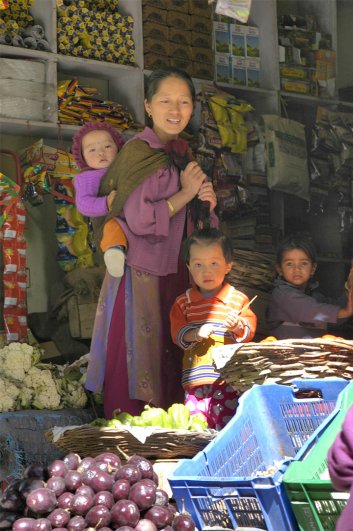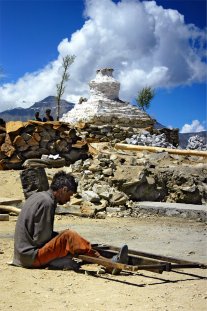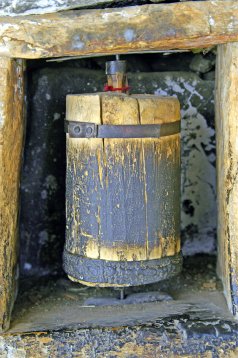Rekong Peo - Nako
Access to upper Kinnaur, the remote region east of Kalpa, is
restricted. Only visitors with Inner Line permits can travel beyond the
checkpoint at Khangi, and on to the confluence of the Sutlej and Spiti rivers.
Five to six hours by jeep from Rekong Peo, within a day's walking from the
Tibetan border, the tiny hamlet of Puh is the area's main settlement, chosen by
the Dalai Lama in summer 1992 as the venue for the Kalachakra ceremony.
Buddhists from all over the world - includi ng
Richard Gere and Cindy Crawford, whose arrival almost upstaged the great man
himself - flocked here to listen to Tibet's leader-in-exile read from a secret
and highly auspicious text, which is believed to divulge a super-fast short-cut
to Enlightenment. Evidence from inscriptions suggest that Puh was, in the
eleventh century, an important trading centre that fell under the influence of
the Tibetan kingdom of Guge when the Great Translator, Rinchen Zangpo moved
through the area spreading the faith. The temple in Puh dedicated to Shakyamuni,
with wooden columns supporting a high ceiling and a circumambulatory path around
the altar, reflects the plans laid out elsewhere by Rinchen Zangpo.
ng
Richard Gere and Cindy Crawford, whose arrival almost upstaged the great man
himself - flocked here to listen to Tibet's leader-in-exile read from a secret
and highly auspicious text, which is believed to divulge a super-fast short-cut
to Enlightenment. Evidence from inscriptions suggest that Puh was, in the
eleventh century, an important trading centre that fell under the influence of
the Tibetan kingdom of Guge when the Great Translator, Rinchen Zangpo moved
through the area spreading the faith. The temple in Puh dedicated to Shakyamuni,
with wooden columns supporting a high ceiling and a circumambulatory path around
the altar, reflects the plans laid out elsewhere by Rinchen Zangpo.

Khangi checkpoint
Puh family
The highway surface being in constant need of repair and
landslide clearance families of workers are encountered at sporadic intervals
along its route. As transport is infrequent and pay so poor they live "on the
job" in the most appalling conditions - a tarpaulin stretched over a few rocks
by the roadside or makeshift dwellings of old oil drums cut and unrolled to form
sheets. It is very distressing to see that children are born into this
environment.

Beyond
Puh, the road bends north, crossing the Sutlej for the last time at Khabo, near
the Spiti confluence. To the northeast Leo Pargial II at 6770m (pictured in the
clouds to the right), Kinnaur's highest peak, rises in a near vertical
4000-metre wall of cream-coloured buttresses and pinnacles to mark the
international frontier, as the Sutlej is seen disappearing to its source high up
on the Tibetan plateau. A truly dramatic location. The mountain also overlooks
the old Indo-Tibet road as it enters China via the Shipki La pass (5569m). The
present road, meanwhile, winds north above the Spiti river through the barren
wastes of the Hanglang Valley. Within the rain shadow of the Himalayas, this far
eastern edge of Himachal Pradesh, with its deep blue skies, crisp clear light
and arid mountain scenery, closely resembles Ladakh. Its only settlements are
small scatterings of cubic dry-stone or mud houses with roofs piled high with
fuel (twigs, dried dung) and fodder, and surrounded by thickets of shimmering
poplars, apricot groves, and terraces of barley.
Nako, the largest village, nestles high above the east side of
the river at an altitude of 3800m around the banks of a small circular lake.
Terraced fields of barley and peas, and long mani walls lead to a settlement
built around a labyrinth of paths with eight temples at each of the cardinal
points.


Approaching Nako
Nako lake
Our hotel accommodation was double-booked so we were "relegated"
to tents up the hill but as it turned out what a view!



The eleventh-century complex of the Nako Chokhor at the northwest
corner of Nako, attributed to Rinchen Zangpo, now being restored, houses
exquisite paintings comparable to those of Alchi in Ladakh. The finest building
of all is the Serkhang or "Golden Hall" dedicated to the Tathagatas or Supreme
Buddhas. Each of the inside walls is decorated with lavish mandalas (symbols of
the universe) made of stucco and enhanced with fading gold leaf.
An impending visit by the
Dalai Lama to teach had resulted in a frenzy of building employing men women and
children. A new temple and housing for His Holiness were being constructed out
of timber which must have travelled a great distance considering the barrenness
of the surrounding landscape. 


Sawing timber for................................................... the Dalai
Lama's house........................................................ and sharpening the
saw



Very old prayer wheel
Nako through temple doorway
Ceremonial dress

NEXT PAGE
 ng
Richard Gere and Cindy Crawford, whose arrival almost upstaged the great man
himself - flocked here to listen to Tibet's leader-in-exile read from a secret
and highly auspicious text, which is believed to divulge a super-fast short-cut
to Enlightenment. Evidence from inscriptions suggest that Puh was, in the
eleventh century, an important trading centre that fell under the influence of
the Tibetan kingdom of Guge when the Great Translator, Rinchen Zangpo moved
through the area spreading the faith. The temple in Puh dedicated to Shakyamuni,
with wooden columns supporting a high ceiling and a circumambulatory path around
the altar, reflects the plans laid out elsewhere by Rinchen Zangpo.
ng
Richard Gere and Cindy Crawford, whose arrival almost upstaged the great man
himself - flocked here to listen to Tibet's leader-in-exile read from a secret
and highly auspicious text, which is believed to divulge a super-fast short-cut
to Enlightenment. Evidence from inscriptions suggest that Puh was, in the
eleventh century, an important trading centre that fell under the influence of
the Tibetan kingdom of Guge when the Great Translator, Rinchen Zangpo moved
through the area spreading the faith. The temple in Puh dedicated to Shakyamuni,
with wooden columns supporting a high ceiling and a circumambulatory path around
the altar, reflects the plans laid out elsewhere by Rinchen Zangpo.












